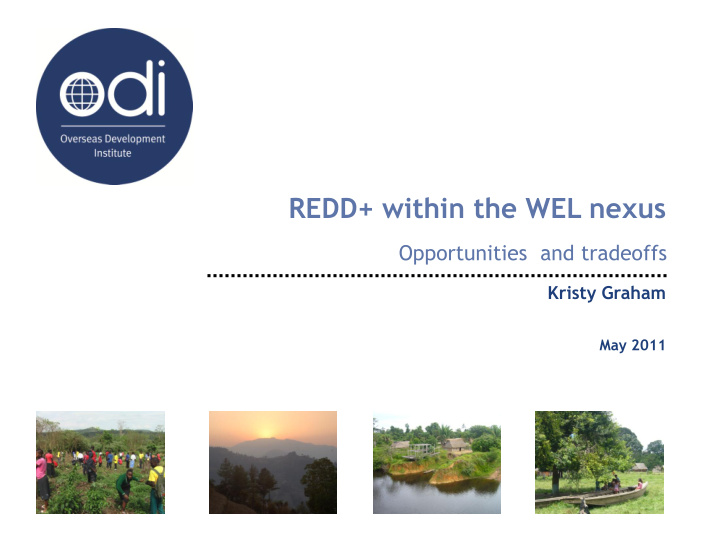



REDD+ within the WEL nexus Opportunities and tradeoffs Kristy Graham May 2011
Outline • What is REDD+? • REDD+ as a land use option • Tradeoffs of using land for REDD+ vs other uses • Tradeoffs will depend on policies in other sectors e.g. energy, agriculture • Governance and its importance for REDD+ • Suggestions for further work 2
Definition Scope • Cancun Agreements: Encourages developing country Parties to contribute to mitigation actions in the forest sector by undertaking the following activities: (a) Reducing emissions from deforestation; (b) Reducing emissions from forest degradation; (c) Conservation of forest carbon stocks; (d) Sustainable management of forests; (e) Enhancement of forest carbon stocks; Financial transfer • any international financial transfer mechanism that aims to reduce – emissions from the forest sector, and reduce emissions from land use change from forest to non-forest. 3
REDD+ as a land use option Aims to provide incentives to limit land use change • from forest to non-forest, but what is it competing with? – Agriculture • Food production • Cash crop production e.g. Palm oil • Biofuel feedstock production e.g. sugar, soy Aims to provide incentives to reduce emissions within • the forest sector. Competes with – Intensive timber harvesting – Fuel wood and charcoal industries – Illegal logging activities 4
Tradeoffs There are tradeoffs that will need to be made if • countries decide to implement REDD+. Costs and benefits at the national, regional and local • levels. Cost Benefit Analysis of REDD+ vs other land uses, • and also of different strategies to implement REDD+. – WBI manual – Indonesia REDD+ v Palm Oil – Broader CBA for Indonesia 5
Graphical demonstration of economic tradeoffs 6 Source: WBI 2011
Links with other sectors Many of the drivers of deforestation and degradation • are in other sectors e.g. agriculture and energy The tradeoffs involved in REDD+ will depend heavily • on policies in the other sectors – Energy policies in within a country if wood fuel industry is a driver of DD – International bioenergy policies if biofuel feedstock production directly or indirectly drives deforestation – Diet preference in western and emerging economies driving increased agricultural production – Agricultural support policies where they alter the economics of agricultural expansion and/or intensification 7
Comparison of REDD+ with other land uses Economic Environment Environment Social (non carbon) (carbon) Intensive + - - +/? logging Agroforestry + + + + (REDD+) Food + -/? ? + production Biofuel + Locally = - -/? ? feedstock Globally = +/? production Forest ? + + ? conservation 8 (REDD+)
The importance of governance To be effective REDD+ should involve transformation • of land use. Will require broad political support high level to local • level. Ensuring it contributes to inclusive growth will require • deliberate policy decisions. Large scale land-use planning will be required to • clearly establish priority areas for different land uses. 9
Further work Case study on how countries are implementing • REDD+ to achieve poverty reduction and inclusive growth e.g. Ecuador, Tanzania. Case study on an area where REDD+ is contributing • to increased competition for land e.g. East Kalimantan in the area covered by the Kalimantan Forest Carbon Partnership which is also an area of palm oil production. Case study of strategic land use planning and how it • has worked in practice. 10
Recommend
More recommend